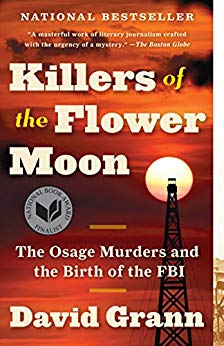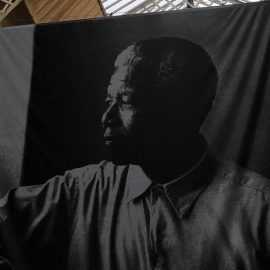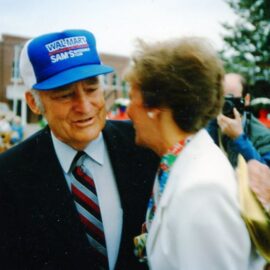

This article is an excerpt from the Shortform summary of "Killers of the Flower Moon" by David Grann. Shortform has the world's best summaries of books you should be reading.
Like this article? Sign up for a free trial here .
What was the Osage oil murder conspiracy? Was the conspiracy ever fully exposed?
In the 1920s in Oklahoma, multiple members of the Osage tribe were killed. Eventually, investigator Tom White connected several murders to each other and then to a man named William Hale. White’s investigation revealed a plot to kill the Osage for profit.
Continue reading to learn about this infamous murder conspiracy.
Oil and the Osage Murder Conspiracy
In the late 19th century, the Osage Nation, a Native American tribe of the Great Plains, unexpectedly became one of the wealthiest per-capita groups in the world. Military incursions by the U.S. Army and land expropriation by white settlers over the course of the century had confined the Osage people to a reservation in a small corner of northern Oklahoma, a sliver of their once-extensive tribal territory.
The forced migration brought poverty, sickness, and misery—by the 1870s, the population of the tribe was a mere 3,000, just a third of what it had been at the dawn of the 19th century, with many people succumbing to smallpox and violent attacks by white settlers. But when oil was discovered in Osage County, Oklahoma in 1897, the Osage were suddenly rich beyond their wildest dreams, with the total tribal income from oil leases running into the tens of millions.
Unfortunately, this oil wealth came at a terrible price. The wealth of the Osage attracted the jealousy and greed of whites in Oklahoma, who resented people they perceived as being their cultural and racial inferiors getting rich for simply having the good fortune to own land above a massive oil deposit. This led to a murder conspiracy that would last for years.
On May 27, 1921, the partially decomposed body of a 25-year-old Osage woman named Anna Brown was discovered in a ravine in Osage County, Oklahoma, dead from a bullet to the back of the head. Anna would be merely one of the first victims in a five-year-long Reign of Terror that would run from 1921-1926 and claim the lives of dozens (and possibly hundreds) of Osage men, women, and children.
Separating Fact From Hearsay
Tom White headed to the Oklahoma City field office in 1925 to lead the Osage investigation. Upon examining the case, he saw patterns in the killings: all were of wealthy Osage or their benefactors, and three (Anna Brown, Rita Smith, and, their mother, Lizzie) were direct blood relatives.
Tom, already suspicious and wondering about some kind of murder conspiracy, methodically ruled out many of the suspects up to that point, including Anna’s ex-husband, by corroborating their alibis. One witness, a young Kaw Indian woman, claimed that another woman named Rose Osage had told her that she’d murdered Anna Brown as revenge for attempting to seduce her boyfriend, a man named Joe Allen. According to the Kaw Indian’s signed statement, Rose and Joe had shot Anna in the back of the head and then dragged the body to the ravine where it was discovered.
But this account failed to match the evidence at the crime scene—Anna’s body showed no signs of having been moved. The Kaw woman admitted that she was lying and that she’d been coerced into signing her false statement by a strange white man who’d showed up at her house. Whoever the conspirators were, they were manufacturing evidence to derail the investigation.
The case was bewildering. The methods of killing were varied: some victims were poisoned, others were strangled, and others were shot. This strongly suggested that the murders were the work of more than one killer. And the unreliability of sources, the reluctance of witnesses to come forward, and blatant corruption of local law enforcement officials made pursuing leads a bewildering exercise. It was near-impossible to separate fact from hearsay. One of the first red flags for Tom was the fact that the Shoun brothers had failed to locate the bullet that killed Anna Brown. He began to suspect that the brothers (who were also caring for Anna’s sister, Mollie) had stolen the bullet during the course of the autopsy.
To help him navigate this rough-and-tumble world, Tom recruited a team of agents who were well-versed in the frontier world and understood the dangers they would be facing. These men went undercover in Osage County, ingratiating themselves with local power brokers and figures of influence—including William Hale.
Bryan Burkhart: Prime Suspect
By July 1925, Tom began to think Bryan Burkhart, brother of Ernest Burkhart (Mollie’s husband) and brother-in-law to Mollie and Rita, was the most likely perpetrator of Anna’s murder and a suspected ringleader of the murder conspiracy. He was the last person to have seen her alive when he dropped her off back home the evening she disappeared. Tom believed this, even though Bryan’s alibi was well-corroborated by people who claimed to have been in his company at the time of the killing, including his brother Ernest and his uncle, William Hale.
But Tom was undaunted, choosing to pursue a lead that had been buried by the original investigators. A group of men claimed to have seen Bryan driving a car with Anna later that evening in the nearby town of Ralston, after the time when he’d testified that he dropped her off at home. Several of these men came forward on the record that they had seen the pair, even though they recognized that they were putting themselves in mortal danger by doing so.
It appeared that Bryan had picked Anna up later, after taking her home, and that he had committed perjury in his original testimony. Pursuing the lead further, Tom spoke with multiple witnesses who now claimed to have seen Anna and Tom together at various times that evening, in the company of a mysterious “third man.” The pair were last seen at 3 a.m, during which Bryan brusquely ushered Anna out of a speakeasy and into his car. This new timeline shattered Bryan’s alibi.
Tom needed to identify who this unknown man was who had been with the couple the night Anna disappeared. Through his sources, he learned that Pike, the shadowy investigator originally engaged by William Hale back in 1921, claimed to know the identity of this third man. But Pike refused to come forward and was only located when he was arrested trying to commit a highway robbery.
Under interrogation, Pike revealed that he had not been hired by William Hale and Bryan Burkhart to help the original investigation—he had been hired to destroy it by manufacturing evidence and generating false leads. One of the tasks he undertook in his mission to subvert justice was to conceal Bryan’s true whereabouts on the night of Anna’s murder. He also added that Ernest Burkhart was sometimes present with his brother and uncle when these plans were discussed— with so many people involved, Tom White was beginning to think the murders were all connected in a murder conspiracy.
If what Pike was saying was true, then the supposedly benevolent William Hale was guilty of obstruction of justice in a murder case. The only question was whether Hale had been acting solely to protect his nephew Bryan from the law, or whether he had been involved in orchestrating Anna’s murder—and possibly dozens of others. It also implicated Ernest Burkhart. Was Ernest guilty of conspiring to kill his wife’s sister, and possibly poisoning Mollie herself? And if so, what was the motive?
Digging Deeper Into the Conspiracy
In September 1925, Tom spoke to the nurse who had been on duty the night Bill Smith died, following the explosion at his house. She revealed that Bill had spoken with his lawyer and with the brothers (and doctors) David and James Shoun shortly before he died and that they had commanded her to leave the room. White was already suspicious of the brothers, suspecting them of stealing the bullet that killed Anna White during her autopsy. This was another step towards Tom White believing this was a murder conspiracy.
Although neither the Shoun brothers nor the lawyer gave up much when questioned, Smith’s lawyer did reveal that Smith had told him that he considered Ernest Burkhart and William Hale to be enemies. Tom also learned that James Shoun had been named the administrator of Rita Smith’s estate at this clandestine bedside meeting, a position that would have put him in a lucrative position to pillage her wealth. Clearly, the Shoun brothers had summoned Smith’s attorney to this meeting to have Smith sign this paperwork surrendering his murdered wife’s estate into their hands, shortly before expiring himself. Given his state, there was no way Smith had done this of rational and sound mind.
Tom was getting close to identifying William Hale as the mastermind of the murder conspiracy. After interviewing more witnesses, he learned that Hale was the beneficiary of the murdered Henry Roan’s $25,000 life insurance policy. Obviously, Hale had a clear-cut financial interest in Roan’s death. And after speaking with the insurance salesman who had sold Hale the policy, Tom learned that Hale had forged a creditor’s note to make it look like he had loaned Roan money and that the policy was merely collateral for this debt. After Roan’s murder, Hale had even schemed to frame another man (who had been having an affair with Roan’s wife) for the killing.
The Headright Plot
The murder conspiracy began to make sense as Tom White examined the ownership of oil headrights. The Osage Tribal Council had decreed that each member of the tribe was to receive an equal share of the royalties from the oil money, known as headrights. Individuals were not permitted to buy or sell headrights—this was done in an attempt to keep the oil money in Osage hands. But they could be inherited. An Osage who suffered many deaths in their family could find himself or herself the owner of multiple headrights.
As he studied the probate records, Tom discovered that many headrights had come into the possession of Mollie Burkhart, married to Ernest Burkhart, nephew of William Hale. Ernest was known to be highly influenced by his domineering uncle. When all of this money came to Mollie, it would be easy for Hale to exercise control of it through his nephew—though it would be even easier if Mollie were to be killed, too.
This explained the precise pattern and order of deaths in Mollie’s family. The divorced and childless Anna had been the first to be eliminated, with her headright going to her mother Lizzie. Killing Anna first ensured that her assets would not be divided up between multiple heirs. Lizzie herself was the next target, having willed her headrights to Mollie and Rita, her surviving daughters.
This also explained why the next victims, Bill and Rita Smith, had died in a bombing attack, which was an unusual method of killing. In fact, the Smith murders were done this way because it was critical that the two died at the same time. If only Rita had died, her headrights would have gone to her husband Bill Smith. But because the couple died mere days apart, Rita’s headright reverted to her only surviving heir—Mollie. It all began to make sense as the outlines of the murderous plot became clear to Tom White. By conspiring to have all the members of Mollie’s family killed, Hale was maneuvering to have all their headrights bequeathed to her. Once Mollie herself was murdered, the oil wealth would be his to exploit.
The murder conspiracy that took place in the 1920s against the Osage had devastating effects. In addition, many believe that William Hale’s murder conspiracy was only one of the many plots to kill the Osage during that time.

———End of Preview———
Like what you just read? Read the rest of the world's best summary of David Grann's "Killers of the Flower Moon" at Shortform .
Here's what you'll find in our full Killers of the Flower Moon summary :
- How the Osage tribe had vast oil wealth, but had it seized by their murderous neighbors
- The brutal and unresolved murders of Osage Native Americans
- The complicated history of the FBI in profiting from the Osage murders






